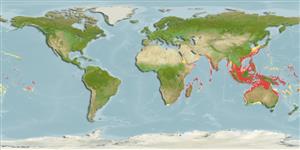Common names from other countries
Environment: milieu / climate zone / depth range / distribution range
Ekologi
laut; payau dasar (demersal); kisaran kedalaman 10 - 110 m (Ref. 12260). Tropical; 26°C - 29°C; 35°N - 36°S, 19°E - 137°W
Indo-Pacific: Red Sea and the east African coast (30° to about 50°S) to Australia and Tahiti, north to the Ryukyu Islands (Ref. 27956).
Size / Weight / umur
Maturity: Lm ? range ? - ? cm
Max length : 21.0 cm FL jantan/; (Ref. 5525); common length : 15.0 cm TL jantan/; (Ref. 5450)
Duri punggung (Keseluruhan (total)) : 8; duri punggung lunak (Keseluruhan (total)) : 15 - 17; Duri dubur: 3; Sirip dubur lunak: 13 - 14.
Found in shallow inshore coastal waters over silty bottoms (Ref. 30573, 90102). Young enters mangrove estuaries or silty reef areas (Ref. 4833, 90102). Searches for prey using a protruding pipette-like mouth or by sieving potential food through their gill rakers (Ref. 26569). Feeds on small fishes, shrimps, other crustaceans, and polychaetes. Sold fresh and dried salted; also made into fishmeal.
Life cycle and mating behavior
Maturities | Reproduksi, perkembang biakan | Spawnings | Egg(s) | Fecundities | Larva
James, P.S.B.R., 1984. Leiognathidae. In W. Fischer and G. Bianchi (eds.) FAO species identification sheets for fishery purposes. Western Indian Ocean (Fishing Area 51). Vol. 2. FAO, Rome. pag. var. (Ref. 3424)
Status IUCN Red List (Ref. 130435)
CITES (Ref. 128078)
Not Evaluated
ancaman kepada manusia
Harmless
penggunaan manusia
Perikanan: komersial
Alat, peralatan
laporan khas
muat turun XML
Sumber internet
Estimates based on models
Preferred temperature (Ref.
115969): 24.5 - 29, mean 27.9 (based on 1548 cells).
Phylogenetic diversity index (Ref.
82804): PD
50 = 0.5312 [Uniqueness, from 0.5 = low to 2.0 = high].
Bayesian length-weight: a=0.01549 (0.01184 - 0.02026), b=3.05 (2.98 - 3.12), in cm Total Length, based on LWR estimates for this species (Ref.
93245).
Trophic level (Ref.
69278): 4.2 ±0.0 se; based on diet studies.
Daya lenting (Ref.
120179): Tinggi, Waktu penggandaan populasi minimum kurang dari 15 bulan (K=0.70-1.30).
Fishing Vulnerability (Ref.
59153): Low vulnerability (14 of 100).
